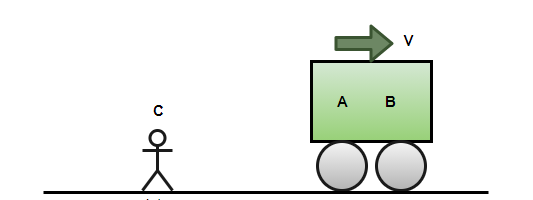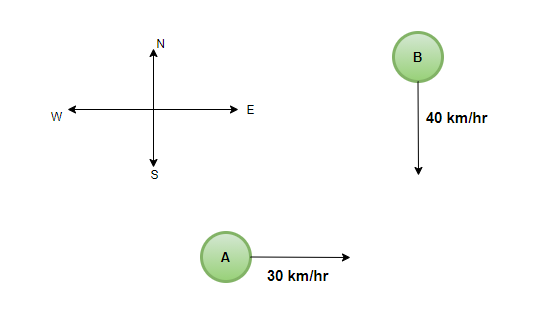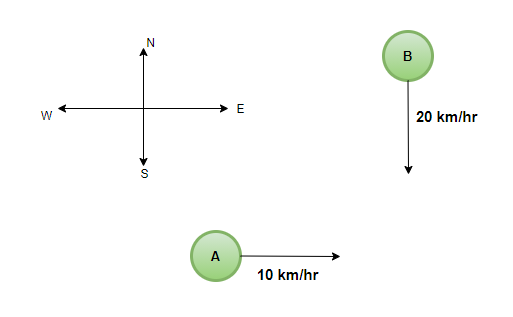二维相对运动
物体的运动不是绝对的或孤立的。它总是相对于一些参考来描述的。例如,移动车辆的速度是相对于地面测量的。该位置也是相对于称为原点的参考来测量的。行驶的火车相对于地面的速度为 100 公里/小时,但如果另一辆火车以 150 公里/小时的速度行驶。相对于坐在第二列火车上的人来说,第一列火车的速度不会是 100 公里/小时。研究物体的相对运动是必不可少的。让我们详细探讨一下这个概念。
参考框架
在物理学中,参考系是一个抽象坐标系,一组唯一固定坐标系的物理参考点有助于标准化相对于该坐标系的测量。考虑下图,小车相对于男孩的速度不为零,但小车相对于坐在车内的人的速度为零。

一维的相对运动
一维中的相对运动是与多维中的相对运动相关的计算的构建块。向量可以分解成它们的分量,然后这个规则可以用来计算不同方向的相对速度。例如,考虑一个人坐在以 10m/s 向东移动的火车上。假设选择东方向为正方向,地球为参考系。
火车相对于地面框架的速度,
v TE = 10 米/秒
现在假设火车上的一个人开始起床并开始向与火车相反的方向移动。他在火车内以 2m/s 的速度移动。这个速度是相对于火车框架的参考。人的速度是,
v PT = -2 米/秒
可以将这两个向量相加以求出人相对于地球的速度。这称为相对速度。
v PE = v PT + v TE
二维相对运动
这些概念也可以扩展到二维空间。在下图中,考虑一个粒子 P 和参考帧 S 和 S'。在 S 中测量的坐标系 S' 的位置是 r S'S ,相对于坐标系 S' 测量的粒子 P 的位置由 r PS'给出,并且粒子 P 相对于参考坐标系的位置S 由 r PS 给出,

从图中注意到,
r PS = r PS' + r S'S
这些向量也为我们提供了相对速度的公式,对上述方程进行微分,
![]()
⇒ ![]()
直观地说,粒子相对于 S 的速度等于 S' 相对于 S 的速度加上粒子相对于 S 的速度。
再次微分这个方程,加速度方程由下式给出,
![]()
⇒ ![]()
质点相对于 S 的加速度等于 S' 相对于 S 的加速度加上质点相对于 S 的加速度。
示例问题
问题 1:一列火车以 100 公里/小时的速度行驶。坐在火车内的人开始以 10 公里/小时的速度向火车方向移动。求人相对于地面的速度。
回答:
Given:
velocity of the train with respect to the ground, vTG = 100Km/h
velocity of the person with respect to the train, vPT = 10Km/h
velocity of the person with respect to the ground vPG,
The equation mentioned above states,
vPG = vPT + vTG
plugging the values into the above equation,
⇒ vPG = 100 + 10
⇒ vPG = 110
问题 2:一列火车以 100 公里/小时的速度行驶。坐在火车内的人开始以 10Km/h 的速度向与火车相反的方向移动。求人相对于地面的速度。
回答:
Given:
velocity of the train with respect to the ground, vTG = 100Km/h
velocity of the person with respect to the train, vPT = -10Km/h
velocity of the person with respect to the ground vPG,
The equation mentioned above states,
vPG = vPT + vTG
plugging the values into the above equation,
⇒ vPG = 100 – 10
⇒ vPG = 90
问题 3:车辆以 3i + 4j m/s 的速度移动。车内的人认为这只鸟以 2i + 2j m/s 的速度飞行。求小鸟相对于直线的速度。
回答:
Given:
velocity of the vehicle with respect to the ground, vVG = 3i + 4j
velocity of the bird with respect to the vehicle, vBV = 2i + 2j
velocity of the person with respect to the ground vBG,
The equation mentioned above states,
vBG = vBV + vVG
plugging the values into the above equation,
⇒ vPG = 2i + 2j + 3i + 4j
⇒ vPG = 5i + 6j
⇒ |vPG| = √61 m/s
问题 4:如图所示,两个粒子 A 和 B 分别以 30Km/h 和 40Km/h 的速度向一个交叉点移动。求粒子 A 相对于粒子 B 的速度。

回答:
Given: vA = 30 Km/h and vB = 40 Km/h.
Figure shows they are moving in perpendicular directions.
Velocity of A with respect to earth: vAE = 30i
Velocity of B with respect to earth: vBE = -40j
Using the equation studied above, velocity of A with respect to B: vAB
Assuming that the earth is the connecting frame of reference here,
![]()
⇒ ![]()
⇒ ![]()
⇒
magnitude of this velocity is
⇒
⇒
问题 5:如图所示,两个粒子 A 和 B 分别以 10Km/h 和 20Km/h 的速度向一个交叉点移动。求粒子 A 相对于粒子 B 的速度。

回答:
Given: vA = 10 Km/h and vB = 20 Km/h.
Figure shows they are moving in perpendicular directions.
Velocity of A with respect to earth: vAE = 10i
Velocity of B with respect to earth: vBE = -20j
Using the equation studied above, velocity of A with respect to B: vAB
Assuming that the earth is the connecting frame of reference here,
![]()
⇒ ![]()
⇒ ![]()
⇒![]()
magnitude of this velocity is
![]()
⇒ ![]()
⇒